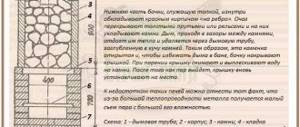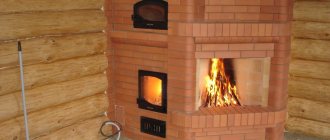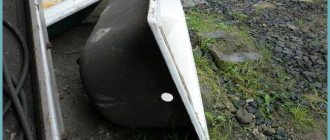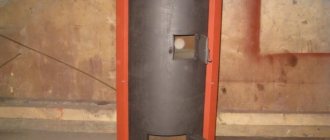In order to have a great time in the bathhouse, you first need to heat it. Everyone knows that a sauna stove consists of several basic elements. The main element is the firebox. One of its most practical options is heating a bathhouse from the street. It is the firebox that is responsible for the speed of heating the bath and its quality, so when choosing a firebox you should be extremely demanding. The basic requirements for a sauna firebox are as follows:
- maximum heat transfer;
- minimum fuel consumption;
- long service life;
- should fit into the design of the bathhouse interior.
The modern market offers a lot of options for choosing a firebox. If we consider the classification according to the type of fuel that will be used in the future, then this is a wood firebox, a gas firebox, and an electric firebox. Of course, each of them has its own characteristics and advantages. Thanks to modern models, the heating process can be made quite comfortable. For example, a firebox from a dressing room, thanks to the provided outlet, greatly facilitates this process. The firebox for the bathhouse can also be placed from the street, but this is less comfortable. (See also: Vulcan stove for a bath)
Another modern version of the firebox is a mechanical firebox. This could be, for example, a tshpm firebox or a tlzm firebox. Both types are designed for burning solid fuels. The advantage of such fireboxes is the ability to burn unburnt fuel. Moreover, before the first repair, they can work for at least 700 hours, and the total service life of such a firebox exceeds 10 years.
Among the advantages of wood-burning stoves are the quality of steam, the simplicity of the design itself, reliability, durability and efficiency. Electric sauna fireboxes are also widely used today. It is very convenient, as it does not require much attention during the heating process. The combustion process in such a firebox is most often regulated using a special remote control. A sauna firebox of this type is also a very good option, since it has several operating modes. Such fireboxes are safe and quite environmentally friendly. The only downside is high energy consumption.
Gas fireboxes are not used as often, but they also have their advantages. These fireboxes are easy to use and very practical. They do not require the investment of time and financial resources, like wood-burning fireboxes. A striking example is the vortex furnace. (See also: Cast iron fireplace inserts)
Using a sauna stove with an external firebox
Experienced builders and experts in the field of bathhouse construction often give users recommendations for placing the sauna firebox outside the steam room. This method of arranging the firebox allows you to guarantee heat for both the steam room and the dressing room, where a relaxation room is often organized. But this is far from the only advantage of a remote oven.
- When using a wood-burning stove outside the steam room, you can completely eliminate the risk of introducing garbage, sawdust, snow, soot, etc. into a room that requires high-quality hygiene. After all, you can heat the bathhouse from another room.
- The remote firebox greatly simplifies the process of servicing the steam room itself. In order to maintain the air temperature in the room at a sufficient level, there is no need to constantly enter it, add firewood, monitor the temperature, while opening doors through which heated air easily escapes.
- Even if there is unburnt fuel left in the firebox, placing it outside the steam room will eliminate the risk of carbon monoxide poisoning.
- Using a sauna stove from a dressing room will save the usable area of the steam room (the firebox, as well as the space for its safe operation, require on average one extra square meter).
- If we are talking about the construction of a commercial bathhouse in Nizhny Novgorod, a remote sauna firebox from the dressing room, located in a separate boiler room, will avoid constant inconvenience to clients in the steam room.
Installation of a stove in a brick wall in a residential building
So, if the wall is brick, then it is not necessary to prepare a recess in it for installing a stove. If there was previously a doorway in it, you can use it. Everything will be much simpler here. It is enough to cut a through hole with a side of 40-60 cm. A metal support is installed below, on which the entire structure will be located. Next, a box is formed from the back of the wall (naturally, you will have to make a rather long protrusion for the chimney, because it also requires at least 40-50 cm). If necessary, a 20 mm indentation is made between the support and the floor. This is also necessary for fire safety purposes. All that remains is to install the stove in the wall and line it with brick. Experts recommend doing this either white or red heat-resistant, but half (that is, when the brick is placed lying down).
Foundation for a brick kiln.
In a bathhouse, the stove is mounted in a similar way if one of the walls there is also brick (for example, which is located between the locker room and the steam room). The only difference in the algorithm for installing a stove in a residential building and in a bathhouse is the distance from the base of the floor. If in a residential building it is customary to place the stove as low as possible, then in the bathhouse it is higher in order to quickly fill the upper part of the steam room with warm or hot air. But still, there are no clear rules on how stoves should be located in a bathhouse. And not only traditional stoves can be used there, but also even fireplaces, and even electric stoves, in which heating is carried out by convection of hot air.
How to equip a remote sauna stove
There are several ways to arrange a sauna stove with an external firebox. Each of these methods has its own advantages and features. Note! Experts recommend abandoning the idea of installing a sauna stove firebox in a washing room. Using this room to fire a wood-burning stove guarantees the same disadvantages as using the firebox directly in the steam room. The same garbage that will constantly remain on the floor, the same risk of carbon monoxide poisoning. The only option in which placing the stove in the washing room is justified is the large area of this room.
Bringing the firebox into the dressing room: the main arguments for this option
Installing a sauna stove from a dressing room allows you to obtain certain advantages:
- the presence of special stoves with ceramic glass doors allows you to provide the dressing room with a stylish appearance and make the room more comfortable for relaxation;
- in winter, in order to additionally heat the dressing room, it will be enough to open the firebox slightly and let the heat from burning coals into the room;
- You can constantly monitor the temperature level in the steam room without leaving the sauna.
Additional decorative design of the firebox in the dressing room will only be beneficial. It is important to take into account that people often rest in the waiting room. And if the bathhouse is designed for a large number of people, it is necessary to take care of proper placement in such a way as not to disturb vacationers while adding firewood and operating the stove.
Correct laying of the stove
Where do you start laying a stove in a brick wall with your own hands? As mentioned above - from the formation of a recess for the chimney, the stove itself and the vent. If the chimney has not yet been formed, it is done first. The best option is to form it from heat-resistant brick at the maximum height, that is, without transitions. It is also desirable that the upper part of the chimney is located at a height of approximately 4.5 m or higher. If it is lower, it will often blow into the oven when there is a strong wind outside. Because of this, the smoke will go back into the ash pit and into the house, and not out.
If the stove is mounted in an opening between a wooden wall, then part of the building structure will simply have to be removed. The wall is supported by a spacer. By the way, if the installation of the stove trim will be carried out in one go, then it is allowed not to make thick inter-pitched seams. You can do without them by simply increasing the density of the solution (adding more concrete) and reducing the distance of the masonry along the seam (instead of the usual 10 mm, make 5 or less).
Scheme of laying furnace rows.
If you look at the shape of the oven from above in cross-section, it turns out that it consists of 4 compartments. This is the best option. You can reduce it to 3:
- blower;
- the combustion chamber;
- chimney (coil).
The fourth chamber in question is where soot accumulates. This part can be completely abandoned only if the stove is installed in a bathhouse. There, anyway, cleaning the chimney must be done 1-2 times a year, since due to the accumulation of moisture, the outflow of smoke is reduced, and sometimes the air duct becomes clogged. In this case, the stove accumulates all the soot in the chimney. It is recommended to make a removable door in the elbow (transition at a right angle) - this is where all the debris and other remnants of solid fuel combustion products will accumulate.
When laying the stove, it is advisable to make the distance from the blower to the combustion chamber as large as possible. In this case, it is better to make the transition between these chambers as narrow as possible - this increases the speed of movement of air masses.
It is impossible to build such a structure only from brick, so experts recommend installing special nozzles made of metal.
Fortunately, they are relatively cheap. There are several advantages to this design. Firstly, the air flow speed increases, and secondly, the consumption of solid fuel and the efficiency of the heating structure decreases. Roughly speaking, this increases efficiency.
//www.youtube.com/watch?v=NRuK86L1VkI
Firebox in a separate boiler room
Often, a remote stove for a steam room is not located in the room where people constantly relax while visiting the bathhouse, but in a separate small room that serves as a boiler room. In addition to the firebox, this room may contain only a small amount of firewood or other fuel for servicing the stove, as well as special tools for lighting the firebox.
You can use both a sauna vestibule and a separate extension, which is often called a “furnace room,” as a boiler room. This placement of the firebox also has its undeniable advantages:
- The most important advantage of a boiler room is that you eliminate the possibility of the specific smell of burnt wood appearing in the bathhouse, which may not always be pleasant.
- In addition, a separate room eliminates the possibility of debris appearing in the “clean” area of the bathhouse.
- A specially equipped room allows you to avoid bringing firewood and other equipment that may be needed to service the stove directly into the bathhouse.
- The percentage of carbon monoxide poisoning is reduced to zero.
However, it should be taken into account that if, for example, the bathhouse is located in the courtyard of a private house and you use it yourself, you will have to go to the boiler room from time to time during your vacation in order to maintain the temperature regime.
Structure of the structure
So, if you are using straight brickwork, then the simplest option for installing a heating stove is to install a metal independent frame with a ash pit and a chimney (more precisely, an exit to it).
All this remains to be covered with red heat-resistant brick (preferably hardened, which has already been heated to several thousand °C). The installation structure can be either flat or with a coil (that is, a curly bend along the chimney, which allows you to leave more heat in the room than with a direct blowing system).
Brick oven diagram.
Similar systems can also be used when a stove is installed in a bathhouse. In this case, the structure is installed in the opening between the rooms, where the most ordinary wood (meaning a log house) is used as a partition. Here the arrangement of the stove is complicated by the fact that it is necessary to insulate the wooden base from heat and heat. Here again you can use ceramic slabs and the most common heat-resistant bricks. The distance from the base itself (rough) and the slab should be at least 15 cm of air space. Only in this case can we say that safety precautions are fully observed.
It is worth noting that after installing the stove, the adjacent wall is under no circumstances covered with a layer of decorative plaster or similar building material. The best option is to cover it with dark-colored tiles or create an air gap inside. But the latter option will reduce the performance of the heating structure, so it is better not to focus on it.
Safety measures when laying brick kilns
The quality of the brickwork directly affects the fire safety of the furnace during its operation. If the work is done with poor quality, the stove will sink to a sufficiently large height, which will lead to multiple chips, cracks and spalling of the mortar from the masonry joints. Fire and hot gases entering the room through them can cause a fire. The likelihood of a fire also increases significantly in cases where soot is not removed from the smoke ducts in a timely manner, or the rules for firing the furnace are violated.
The structural elements of the room in which the stove is located, in cases where they are made of wood or other flammable materials, are placed at a certain distance from the stove . In this case, the minimum value of the specified distance is specified by the relevant regulatory documents. If there are reasons that prevent compliance with this distance, then the following requirements are met. All structural elements of the room that are closer to the walls of the furnace than required by fire safety rules are insulated with special materials (asbestos sheets or sheets of technical felt, previously soaked in a clay solution).
In those places where the chimney of the heating device passes through the interfloor ceilings or roof, a special cutting (fluffing) is performed.
Standards for masonry thickness depending on the distance “smoke - combustible base” are given in Table 1.
If, according to the project, the stove will be laid out between flammable wooden partitions (interior walls), then the minimum distance from them
to the stove wall should be 130 millimeters . Additionally, it is necessary to insulate the wall on the cutting side. The minimum permitted distance between the partition and the “smoke” is 250 millimeters . In cases where it is not possible to provide high-quality thermal insulation, this distance is increased to 380 millimeters .
As one of the possible options, a situation can be considered where the side gaps from the stove to the walls are covered with brickwork. In this case, a wall made of wood is covered with a brick wall, laid in a quarter of a brick on felt, pre-impregnated with clay mortar (the so-called “cold quarter”). Between the walls of the furnace and the cold quarter, holes with ventilation grilles are made at the bottom and top, ensuring air circulation in this spatial volume. The required height and width of the cold quarter projections must exceed 250 millimeters.
Do not forget that vertical ligation of the “cold quarter” with the masonry of the stove or pipe itself is strictly prohibited. The ash pit of the stove should not be connected to the underground. The wooden ceilings located above the stove installation site are insulated with a double layer of technical felt, previously soaked in a clay solution. It is possible to apply plaster to the felt and then cover the area with roofing iron. In this case, the zone of such insulation should at least 150 millimeters beyond the external dimensions of the stove on all four sides. Floors made of combustible materials in front of the firebox are also subject to mandatory insulation, which is most often made from a double layer of technical felt, soaked in a clay solution and then covered with a sheet of roofing iron. Standard sheet size is 500*700. The baseboard located near the stove is upholstered with tin or covered with it.
When performing cutting, it is necessary to take into account many additional factors: the settlement of the furnace, pipes, and the building itself. It should be remembered that stone and wooden structures shrink differently. If the former show negligible values, then wooden structures can sag up to 150 millimeters . The walls may rise slightly when caulking work is carried out. When the walls settle, the floors resting on them also sink. This can lead to cracks and, as a result, a fire. In cases where the expected settlement of the walls may exceed the settlement of the pipes (both mounted and main), the cutting is done in such a way that it has free movement into the room. If the pipes or stove show a settlement that exceeds the calculated settlement of the ceiling and walls, the fluffing should be carried out with a margin upward (towards the attic).
During construction, attics are often filled with lightweight materials that have low thermal conductivity and are quite flammable (hay, dry leaves, sawdust, peat, etc.). From above, all this is covered with slag, earth or sand. The thickness of the top layer must be at least 20 millimeters. In such cases, the cutting should be raised above the backfill layer by at least 70 millimeters, and along its perimeter a backfill should be made of non-combustible materials, the thickness of which should be 100 millimeters or more. The distance from the wooden sheathing (rafters) to the outer surface of the brick pipe must be at least 130 millimeters. And between the pipe and the combustible roof - 260 millimeters. The remaining gaps should be covered with sheets of roofing iron or asbestos cement.
Furnaces and pipes should be periodically inspected in order to detect possible emerging defects and promptly eliminate the latter.
Features of a steel fireplace stove
So, if you can’t assemble a stove-fireplace for a bathhouse with your own hands, then you need to buy it, but in this case we can only talk about a steel structure. The main condition for such a design is a body made of fireproof and high-strength metal, which will quickly and effectively heat the stones for subsequent transfer of thermal energy throughout all rooms of the bathhouse.
In this regard, top manufacturers have long been using exclusively high-strength alloy steel in the production of their furnaces, which meets all technical requirements.
The positive aspects of such a stove-fireplace:
- ensures the fastest heating of the bath;
- the conversion level in such a furnace increases significantly;
- there is no need to create an additional foundation for it;
- installs quickly and easily;
- The service life is very long.
There are three ways to install such stoves:
- hang;
- built into the wall;
- take the firebox into the next room.
In addition to such installations, manufacturers include a water tank, which expands the range of functions of the oven. Typically, such tanks are made of high-strength stainless steel, and their volume starts from 50 liters. You can modify the stove in different ways: by placing the tank on the side or directly above the firebox.











